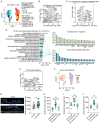This is a preprint.
Adaptive immunity to retroelements promotes barrier integrity
- PMID: 39149266
- PMCID: PMC11326312
- DOI: 10.1101/2024.08.09.606346
Adaptive immunity to retroelements promotes barrier integrity
Abstract
Maintenance of tissue integrity is a requirement of host survival. This mandate is of prime importance at barrier sites that are constitutively exposed to the environment. Here, we show that exposure of the skin to non-inflammatory xenobiotics promotes tissue repair; more specifically, mild detergent exposure promotes the reactivation of defined retroelements leading to the induction of retroelement-specific CD8+ T cells. These T cell responses are Langerhans cell dependent and establish tissue residency within the skin. Upon injury, retroelement-specific CD8+ T cells significantly accelerate wound repair via IL-17A. Collectively, this work demonstrates that tonic environmental exposures and associated adaptive responses to retroelements can be coopted to preemptively set the tissue for maximal resilience to injury.
Figures





References
-
- Di Domizio J, Belkhodja C, Chenuet P, Fries A, Murray T, Mondejar PM, et al. The commensal skin microbiota triggers type I IFN-dependent innate repair responses in injured skin. Nat Immunol. 2020;21(9):1034–45. - PubMed
Publication types
Grants and funding
LinkOut - more resources
Full Text Sources
Research Materials
